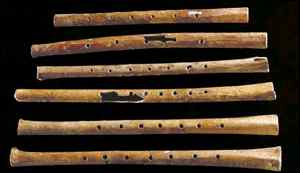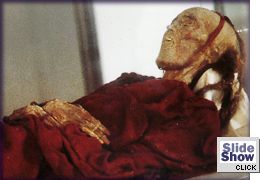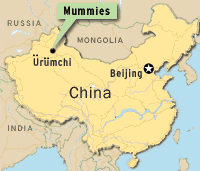

September 22, 1999 - Reuters - London
Archaeologists have found the world's oldest playable flute in China.
The 9,000 year-old, 8.6 inch instrument in pristine condition has seven holes and was made from a hollow bone of a bird, the red-crowned crane.
It is one of six flutes and 30 fragments recovered from the Jiahu archaeological site in Henan province.
``They are the oldest playable musical instruments,'' Garman Harbottle, of the Brookhaven National Laboratory in Upton, New York, said in a telephone interview.
A fragment of a 45,000 year-old flute was previously found in Slovenia but it could not be played.
A short rendition of a Chinese folk song called the Chinese Small Cabbage, played on the ancient instrument can be heard on the web site of the science journal Nature where the findings were published Wednesday (http:/www.nature.com).
``It sounds like a modern flute. It has a thin tone. It's very attractive,'' a nuclear scientist, who assisted researchers from the Institute of Cultural Relics and Archaeology in Henan on the project, said.
``As the editor of Nature said, 'It gives you an eerie feeling to hear it played on an instrument that old','' he added.
The researchers believe the site will turn out to be one of the most important Neolithic sites ever found. In addition to proving that the early Chinese were accomplished musicians and craftspeople the Jiahu site also reveals much about their culture.
``It appears that the culture was more advanced than we were giving them credit for.''
``During this period 9,000 years ago, the Chinese in this village Jiahu already had established a village life. They had parts of the city, or village that were devoted to different functions,'' said Harbottle.
Some of the other flutes, which have between five and eight holes, could also be played but produced a cracking sound that alarmed researchers who feared the instruments could be damaged.
The scientists plan to make replicas of the ancient instruments to study their tonal qualities without endangering the instruments.





July 30 1999 - Xinhua News
Beijing, Xinhua - Chinese surgeons were able to perform a craniotomy, the surgical opening of the skull, which is difficult even in modern times, as early as 4,000 years ago.
This is contrary to archaeologists' previous belief that the craniotomy was introduced to China by Arabs after the Tang Dynasty (618-907).
In the latest issue of the journal Archaeology, Han Kangxin and Chen Xingcan, of the Chinese Academy of Social Sciences' Institute of Archaeology, say that several ancient skulls with holes on them were discovered at sites in Qinghai, Henan, Heilongjiang provinces.
Carbon dating indicates that the skull, which was found in a tomb in Minhe County in Qinghai, is the oldest to have had this operation in China and was from the later New Stone Age, about 4, 000 years ago.
A large triangular cut can be found at the top of the skull with traces of scraping around it. There are also two sunken traces on the skull, which Han says might have been left by a strike from a certain instrument, causing a fracture and inflammation of the skull.
There were some bony growths around the hole and the scraped traces are indistinct, he says, meaning that the patient survived for a period of time after the operation.





June 27, 1999 - Xinhua News Agency
"Ancient Chinese people believed that what happened in the heaven was closely connected with what happened on the earth. And when important things happened, they always observed the sky and made astronomical records," said Jiang.
"In Chinese historical documents there are plentiful astronomical records. The records, especially solar and lunar eclipses and planets phenomena, can help us identify many important historical incidents," he said.
"Modern astronomic calculation offers us a new scientific method in archaeological study, which can not be matched by traditional methods," he added.
Earlier this year, Jiang and his fellow researchers consulted the most advanced long-term ephemeris database and traced the chronology of more than 3,000 years ago, pinpointing the exact dates of a well-known ancient war between King Wu of the Zhou Dynasty (11th century BC- 221 BC) and King Zhou of the Shang Dynasty (16th century BC- 11th century BC).
Li Xueqin, China's leading historian and director of the Institute of History under the Chinese Academy of Social Sciences, said using modern astronomy is a good method for solving historical puzzles. "But it must be based on authentic historical documents." he stressed.
Experts say the astronomical method has attracted wide attention in the historic field recently. In a grand project to put precise dates on the three dynasties of Xia, Shang and Zhou, with 170 historians working on 40 specific topics, a quarter of the topics belong to astronomical study. And experts believe that modern astronomy will facilitate historic research.
Xinhua News Agency - May 25, 1999
SHIJIAZHUANG, XINHUA - Chinese scholars have identified a collection of bamboo slips unearthed in a 2,000-year- old tomb as the earliest edition of the Confucian Analects.
The bamboo version was found in a tomb in Hebei Province, which archeologists say belongs to an emperor of the Han Dynasty (206 BC -- 220 AD) and dates back possibly to 55 BC.
The tomb was first discovered in the early 1990s by local farmers who were digging water control facilities. A great number of bamboo slips have been unearthed, but most of the characters on them were illegible and archeologists had to use modern techniques to reveal their true nature. Ultimately they reached the conclusion that some of them were from the Analects, a collection of major doctrines and sayings of the educator and philosopher Confucius (551 -- 479 BC).
The book is more than 2,000 years old and is the earliest edition of a Confucian work ever found, according to Xie Fei, the director of the Hebei Cultural Relics Research Institute, who examined the slips along with scholars from the State Cultural Relics Bureau and Beijing's Palace Museum.
The collection consists of more than 620 bamboo slips, which were used by the ancient Chinese before the use of paper was popularized. They measure 16.2 centimeters by 0.7 centimeters and contain as many as 20 characters each. There are also traces of the silk strings that were used to connect them.


ABC News - April 1999
"His face is at rest, eyes closed and sunken, lips slightly parted; his hands lie in his lap, while his knees and head are tilted up - like a man who has just drifted off to sleep in his hammock. Visitors tend to tiptoe and lower their voices. Mummies found around Urumchi knock the idea that ancient China was free of any Western influence.
"A two-inch beard covers his face. Here and there white hairs glint among the yellow-brown, betraying his age - somewhere past 50. He would have been an imposing figure in life, for he once stood six feet six inches tall." So writes Elizabeth Barber of the one known as Cherchen Man.
Clad in finely woven woolens, he almost looks as if he could rise out of bed and begin another day in what must have been a difficult life.
Cherchen Man has been dead for about 3,000 years. Though his lips no longer move, he speaks volumes about the first settlers in a bleak desert along China's fabled Silk Road. Until a few years ago, he was the last man scholars would have expected to find there.
Uncovering an Unexpected Past
Cherchen Man, along with dozens of other perfectly preserved mummies found in Turkestan, in western China, has stood archaeology on its ears.
Although the mummies have been known to exist for decades, no one paid them much attention until 1987 when Victor Mair, professor of Chinese studies at the University of Pennsylvania, came across them while leading a group of tourists through an obscure museum in the town of Urumchi (also spelled Ürümqi).
Mair was stunned, and not just because their clothing was perfectly preserved. The mummies, he believed, were Caucasian, with high-bridged noses, deep, round eye sockets, and fair hair.
How had they come to be there, so long before any Westerners were thought to have crossed the Ural Mountains into Asia? The implications are profound, suggesting that Westerners may have influenced Chinese culture, which had been thought to arise independently of the West.
Cherchen Man was found in a tomb with three women and a baby. How had they died? Why did they settle in a desert so severe that many have died traveling from one oasis to the next? Were they really from the West?
Unraveling Threads
Mair assembled a team of experts to see what the mummies could tell us. Among them was Elizabeth Barber, professor of archaeology and linguistics at Occidental College in Los Angeles.
For Barber, author of a recently released book, The Mummies of Urumchi, it was an opportunity she had been preparing for ever since she learned to weave at her mother's knee. Barber and Irene Good, another team member, are among the world's leading experts on prehistoric textiles.
The stacks of clothing buried with the mummies were unlike anything seen before. "It just blew me away," Barber says.
For 13 years, Barber had rummaged through Europe from England to Iran, examining the oldest textiles she could find. Outside of Egypt, that consisted of just thumbnail-size fragments.
Even those tiny samples yielded clues about the laborious chore of creating clothing. She learned what kinds of looms they used to weave which patterns, and what raw materials they used.
So when she arrived in Urumqi, she came with a wealth of understanding, but nothing had prepared her for what she saw. "It was like handling 19th century fabric," she says. The mummies had been buried in a salt basin, and the salt kept the material dry.
Clothing Was Non-Native Wool
"The first thing that struck me was that it was all sheep's wool, and that really surprised me. I had expected most of it to be plant fiber," she says.
Sheep aren't indigenous to that part of the world, so those early travelers must have brought sheep with them from the west. The fabric patterns must have been woven on looms similar to those used to create the scraps she found in eastern Europe.
That, along with other clues - grains of wheat were found in some tombs, and wheat is not indigenous to the region - was clear evidence that Cherchen Man was a product of Europe. So, too, were less well-preserved mummies of others found throughout the area, some of whom had died 1,000 years earlier.
Why had they gone to that area, which even today is so desolate that few live there? How had they died?
A Late Addition to a Sealed Tomb
Unlike other tombs in the area, Cherchen Man's final resting place was not designed to be reopened, Barber says. He was buried with the three women, one of whom is presumed to be his wife, and the tomb was sealed.
A few weeks later, the baby's body, also well preserved, was placed above the main burial chamber. The baby, about 3 months old, was wrapped in a bright red shroud. Alongside was a sheep udder fashioned into a nursing bottle.
"It is clear that they (other members of the community) tried to keep the baby alive after the mother and father had died," Barber says, so this wasn't a case of killing the entire family so all could accompany the man into the next life.
None of the mummies show any sign of violence. They apparently died, Barber surmises, from an epidemic. Still unknown, however, is why they were there in the first place.
Civilization in Cherchen Man's Day
"When the earliest of these Central Asian corpses, nestled into the sands of Tarim Basin, about 2000 B.C. or a little after, the pyramids of Egypt had already stood for half a millennium, but the best-known pharaohs, Ramesses II and King Tut were rather more than five hundred years into the future.
"Next door in Mesopotamia, the Sumerians - first inventors of the art of writing - were already dying out and Hammurabi was soon to set up his famous law code; the Greeks and Romans had not yet even arrived in Greece and Italy from the northeast. On the other hand, 'Ice Man,' the Late Stone Age body found in 1991 by hikers in the Alps, had died well over a thousand years before."
"Europe and the Near East were living in the Bronze Age, a period characterized by the use of soft metals. To the east the Chinese had not yet learned to use metal but were already busy domesticating the precious silkworm that would one day lend its name to the famous caravan route of Inner Asia, the Silk Road, along whose stretches the mummies have been found."
- From The Mummies of Urumchi by Elizabeth Barber
CONFUCIUS
One of the most famous people in ancient China was a wise philosopher named Confucius. This chinese man was a well-known leader in philosophy and he also made many wise phrases and theories about the law, life, and the government. Philosophy is a kind of a system of ideas and thoughts that talk about the human's behavior, the rules that you should follow to make a successful life, and about the government. In other words, it's about thoughts and theories that teach other people lessons about principles, or rules, about life and it also teaches you a moral ( sort of like the morals that are at the end of a fable). Confucius is famous for his philosophy because he made many wise sayings in ancient China that helped many people learn about nature, the world, and the human behavior. He also helped the government and the emperor by teaching them lessons on how the emperor should rule his kingdom successfully.
Confucius was born in a poor family in the year 551 B.C., and he was born in the state of Lu. Confucius' life as a child was sad. His father died when he was four years old. His mom kept the family from becoming hungry by working very often, and he sometimes had to stay in his home all by himself. He had an unhappy life as a small child.
When Confucius got married at the age of 19, he worked as a keeper of a market. Then he was a farm worker who took care of parks and farm animals. When he was 20, he worked for the governor of his district. But when Confucius was 22, he became a very good teacher and started his own school. He taught any person who wanted to learn about philosophy. He taught his students about nature and the world. He also taught about government.
Confucius taught in his school for many years. His theories and principles were spread throughout China by his disciples, and soon many people learned from his wise sayings. One of his rules said," If you governed your province well and treat your people kindly, you kingdom shall not lose any war. If you govern selfishly to your people, you kingdom will not only lose a war, but your people will break away from your kingdom." He had also said a wise phrase called the golden rule that is still being used as a rule today. It said,"A man should practice what he preaches, but a man should also preach what he practices."
One day, his students and he passed a grave where they saw a women weeping at a gravestone. She told Confucius that her husband, her husband's father, and her son were killed by a tiger. When Confucius asked her why she didn't leave such a fated spot, she answered that in this place there was no oppressive government. Confucius said," Remember this my child. An oppressive government is fiercer and more feared than a tiger." That meant that the government in the woman's province did not rule the province well. So Confucius said that the government was more feared than a tiger. This was one of the many events he had to give a person a lesson.
Confucius had so many wise principles that he was awarded to be the governor of his province when he was 52. He was a governor so well that a neighboring governor got jealous of him. After Confucius was threaten by the neighboring province, Confucius was forced to be overthrown, or in other words, defeated.
Confucius was then abandoned from his province and he wandered about China for 13 years. When Confucius was 69 years old, he returned to Lu, his home state, and he died there 3 years after settling in Lu. After Confucius died, he was buried in a grave in the city of Kufow. Yet, when the philosopher died, many people honored all of Confucius' work by building temples in every city in China to honor Confucius. Since Confucius' teachings and philosophy was so advanced, it was the education for China for 2,000 years. It is called Confuciusism.
Confucius helped many people learn about many important things in
life. He helped emperors and people solve problems with his stunning
philosophy. The people of China would not have learned such
important morals, or lessons, if it weren't for the famous philosopher
that guided the people in the art of philosophy.
ANCIENT AND LOST CIVILIZATIONS
ALPHABETICAL INDEX OF ALL FILES
CRYSTALINKS MAIN PAGE